Organizational Safety Risk Analysis in Aviation Industry; An STP a Based Framework- Juniper Publishers
Juniper Publishers- Journal of Civil Engineering
Abstract
ICAO recent manuals for both State Safety Policy
(SSP) and Safety Management System (SMS) explicitly concentrate on the
organizational roots of accidents. The Safety Risk Management (SRM)
system, as the core component of both SSP and SMS, consequently are
expected to manage the organizational safety risk. In view of that, this
paper present a new risk analysis framework that can be feasible to
apply as the analyzing logic of the formal SRM; especially, in the start
line of the risk management process. For this reason, the framework is
founded on the System Theoretic Process Analysis (STPA) to cope with the
sociotechnical feature of aviation organization. To apply STPA as the
base of the framework, a customized "Feedback Control Loop” is applied
to model organizational control mechanisms and extracts their hidden
hazards. Furthermore, an innovative concept and procedure are introduced
for "Hazard Activation Likelihood” estimation and
"HazardConsequences”analysis.
Keywords: STPA; STAMP; SMS; Safety risk analysis; Aviation safety
Abbreviations:
State Safety Policy; SMS: Safety Management System; SRM: Safety Risk
Management; STPA: System Theoretic Process Analysis; QC: Quality
Control; R&T: Research & Technology HACS: Activation Consequence
Severity; HAL: Hazard Activation Likelihood; OSCSC: Organizational
Safety Control Structure's Competency
Introduction
Based on Annex 19 of Convention on International
Civil Aviation,each State shall establish an SSP for the management of
safety in the State, in order to achieve an acceptablelevel of safety
performance in civil aviation [1]. Each State also shall require all service providers to implement and maintain an SMS [1].
Since, Safety Risk Management is an important component of both SSP and
SMS, not only States but also all aviation service providers must
implement an appropriate safety risk management system to support their
decision making process.Clearly, the aim of the SMS (and SSP) Safety
Risk Managementprocess is to identify and handle all significant
influences that may impact on aviation safety, when determining
contributing factors for the analysis of consequences of a hazard and
deciding on risk mitigation measures.
On the other hand, the pivotal concept of SMS
and,consequently, Safety Risk Management systemof wich is concentration
on organizational roots of safety hazards and accidents. In fact, in
contrast to conventional safety approach,which centers on the technical
aspect of the system, the SMS changesthe focus to organizational
aspects. This focus changing, of course, is appropriate because many
studies have proven that management short comings and organizational
aspects are major factors in the occurrence of accidents in complex
systems such as aviation industry [2-4].
Based on SMS main concept, which roots in
epidemiological accident models, accident's initiating mechanisms do not
derive from technical components; rather, originate in organisational
and cultural mechanisms, especially the decision-making processes. All
aviation service providers thus must tackle these issues throughan
appropriate Risk Management system that is equipped with proper
techniques to grasp and handle this kind of safety risks.
The main problem is that the safety risks of aviation
organizations - as complex and sociotechnical systems-are not
extractable only by Conventional Risk Analysis Models (like FMEA, FTA,
and other reliability based approaches); especially their complex
organizational-based risks. In fact, traditional safety analysis tools,
which developed based on pure technical system [5]
, are not able to cope with the complexity of sociotechnical systems.
Aviation organization thus should apply systemic approach, as
recommended by ICAO Doc. 9859, to address their safety issues.
According to the above, the main objective of this
paper isthe proposingof an organizational-based systemic risk
analysisapproach, as the central part of the Risk Management System, for
preparing an appropriate framework to initiate Safety Risk Management
process in aviation organizations.
Accordingly, a clear procedure for organizational
hazards identification, as well as a clear logic for hazard probability/
severity analysis is presented in this paper by the following order: at
first, the main concepts of Safety Risk Management are reviewed. Then,
the principles of STAMP and STPA (as the base models for the presented
framework) are expressed. After that, our specific organizational risk
analysis framework is described. Afterward, the practicality of the
framework is proved by a case study, and finally, the summary and
discussion parts are presented.
Main concepts and Based model
Risk management system and the scope of the work
The field of risk management is faced with
difficulties in defining and agreeing on principles. Risks are dealt
with differently across different countries, industries, and sectors [6].
Although terms, definitions, and interpretations are as varied as the
number of sources providing them, we stand our work based on this
definition: The Safety Risk Management system is the overall integrated
process consisting of two essential interrelated and overlapping, but
conceptually distinct components - Risk Assessment and Risk Management1 [6].
Mullai summarize the fundamental parts of this definition as following [6]:
"Risk assessment" combines both Risk Analysis and
Risk Evaluation, providing practically useful and logically structured
inputs and perspectives about risks for "Risk Management" (the decision-
making process, development of policies, strategies, and measures).
"Risk analysis" is a scientific process in which, by
applying a wide range of methods, techniques and tools, risks are
identified, estimated, and presented in qualitative and/or quantitative
terms. "Risk evaluation" is the process of comparing estimated risks
with established risk evaluation criteria (e.g. criteria based on the
best available technology, legal requirements, practices, processes, or
achievements) in order to determine the level or significance of risks
and provide recommendations for the decision-makers at various levels.
Based on the main purpose of this paper, our work is
limited to "Risk Analysis" part of risk management system, which
includes Hazard Identification and Risk Estimation. The "Risk
Estimation" component itself comprises Likelihood Estimation, Consequent
Analysis, and Risk Presentation (Present estimated risks based on a
specific format such as number, index, color, etc.)
Based model for organizational-based hazard identification
Traditional models of hazard identification, which
are summarized as Chain-of-failure-event models, have major inability to
handle organizational factors, managerial (social and cultural) roots,
and the systemic causes in sociotechnical accidents [7].
In contrast, Systemic approach to technical and organizational safety -
which developed by group of researchers, including Rasmussen, Woods,
Dekker, Leveson, and Hollnagel, most of whom come from system
engineering and human factors backgrounds - is able to appropriately
tackle the safety issues of the complex sociotechnical systems [2,8].
The systemic view of safety, and its related
techniques, considers accident as the consequence of Hierarchical Safety
Control Structures deficiency; therefore, tries to analyze the root
cause of gradual deficiencies among the hierarchical control structures
by applying holistic and systemic approaches [9].
Related studies have shown that the systemic approaches could be
effective tools to model organizational interaction and analyze accident
causation within system's hierarchical control structures [10].
While several researchers have proposed the systems
approaches to safety, Leveson's STAMP (Systems-Theoretic Accident
Modeling and Processes) approach has an outstanding superiority and
provides a perfect view of the organizational aspects of safety [11].
Systems-theoretic accident modellingand processes (STAMP):
STAMP was created to capture more types of accident causal factors
including social and organizational structures, new kinds of human
error, design and requirements flaws, and dysfunctional interactions
among non-failed components. Rather than treating safety as a failure
problem or simplifying accidents to a linear chain of events, STAMP
treats safety as a hierarchical control problem in which accidents arise
from complex dynamic processes that may operate concurrently and
interact to create unsafe situations [12].
STAMP taking into account all facets relating the
social to the technical aspects, and like the general systems approach
to engineering, focuses on the system as a whole, not on the parts or
components individually. It assumes that some properties of systems can
be treated adequately only in their entirety. These "system properties"
derive from the relationships between parts of systems: how the parts
interact and fit together. Concentrating on the analysis and design of
the whole as distinct from the components or parts provides an important
advantage for STAMP to study safety of the complex systems.
STAMP considers systems as interrelated components
that are kept in a state of dynamic equilibrium by feedback loops of
information and control [13].
According to this model, accident (systemic accident) could be the
result of the dysfunctional performance of adaptation feedback control
loop; the controls that may be managerial, organizational, physical,
operational, or manufactural. In this view, accidents can be
characterized as the resulting from an adaptive feedback function that
fails to maintain safety, when performance changes over time to meet a
complex and changing set of goals and values [7].
STAMP practicality has been demonstrated by applying
it to a number of real and complex systems, including a risk analysis of
the organizational structure of the Space Shuttle program after the
Columbia loss [14]; tradeoffs among safety, budget, schedule, and performance risks in the new NASA space exploration mission organization [9]; unmanned spacecraft design [15];
a safety assessment of the new U.S. missile defense system; safety in
the pharmaceutical industry; and safety of outpatient surgery at
Boston's Beth Israel Deaconess Hospital [16], and many other recent studies.
System theoretic process analysis (STPA):
Leveson restated that STAMP considers a set of new causality factors for
accidents that none of former risk analysis methods can analyze them [13].
She, consequently, developed the STPA method in order to be possible to
consider all accident's important aspects and features in process of
hazard analysis. Experiences indicate that Leveson has gone the right
way because it is admitted by researchers that STPA is significantly
more powerful than failure-based techniques in the ability to capture a
wider array of hazardous behaviors, including organizational aspects,
requirements flaws, design errors, complex human behavior, and component
failures. [17]
In respect to STAMP logic, STPA considers accident as
result of inadequate control. In fact, STPA accepts that a set of
control components and particular interactions have evolved or embedded
in system as safety hierarchical control structure; these components and
their interrelation mechanisms - in the form of feedback control loop -
continually monitor and constrain, by use of Control Actions, the
system's behavior to control its dynamicity. In this described
condition, accidents occur if a specific control mechanism for
restriction of a particular system hazardous behavior doesn't exist or
existing control mechanism doesn't able to enforce an expected Control
Action.
Basically, STPA concentrates on high-level risks and system's safety constraints to:
o Perform responsibility gap analysis by assessing control components responsibilities and analyzing the probable gap;
o Cognize systemic hazardous behaviors by identifying unsafe Control Actions;
o Accommodate high-level safety constraints into
lower levels to control hazardous behaviors; and propose new control
mechanisms for enforcement of the new constraints if needed.
o Identify root causes of system's hazardous behavior
by analyzing the components of Feedback Control Loop to correct the
loops' mechanism.
Although STPA is relatively new compared to
traditional methods, it has been demonstrated successfully on a wide
range of systems including aviation [18] , spacecraft [19], missile defense systems [20], aviation maintenance [21], civil infrastructure [22], and others.
Additionally, while STPA is a hazard analysis
technique developed for analysis and design of system safety
architectures, its basis in control theory and system engineering lends
to the application of it to social, and non-safety related control and
early risk management. Some of the most important samples of this
extension include cyber security [23] , business systems and financial operations [24], and the impact of political systems on failures of public infrastructure [25].
The New Approach for Organizational-based Safety Risk Analysis
Why not the original form of STPA
Although the presented risk analysis framework mainly
stands on the principles of STPA, this method is not applicable to
initiate a formal risk management process in aviation organizations in
its original form. This is firstly because the hazard identification
process of STPA is fairly complex, detailed and comprehensive.
Therefore, it is not appropriate for initiating a formal risk analysis
process.
Secondly, and the most important, for the lack of
"Risk Estimation Procedure" organizations are not able to use STPA as
their formal Risk Analysis Framework; particularly at the initiating
phase. In fact, although the STPA - and other STAMP- based methods -have
been had invaluable achievement regarding revealing the hidden causes
of the catastrophic accident in the complex sociotechnical system, they
do not propose a procedure to estimate the risk of the identified
hazards. These model, therefore, are not applicable as a formal risk
analysis framework [26].
Certainly, the reluctance toward developing a risk
estimation procedure - exactly quantification of probability and
severity - in STAMP-based methods derives from both essence of the
complex systems and the superior awareness of the models' architects
toward the effect of the system complexity on cause- effect modeling. In
fact, while modeling the cause and effect chains between initiating
mechanism and the final consequence is the prerequisite step of risk
quantification, anticipating and modeling the interrelation between
system's components as well as the relation between system behavior (as a
consequence) and its components performance is impossible in the
complex sociotechnical system. In truth, after finding a specific
hazardous performance of a system component, it is impossible to trace
all chains of events that may start from that specific hazardous
performance and be over to a probable accident scenario. As a result,
the probability estimation is impossible. On the other hand, since the
specific consequence of the hazardous system's component performance is
not clear, the severity of associated consequence is not estimable too.
Nevertheless, if there were enough historical data
for making a relation between the "presence of specific hazards" and
"occurrence of a particular mishap", the risk estimation would be
applicable, even without modeling the cause-effect relations. Enough
pertinent data, however, is not available in such complex systems,
especially for organizational malfunction mechanisms.
Some researchers have proven that there is very
little scientific data validating probabilistic risk assessment or
evaluating the methods for calculating it, particularly for complex
engineered systems [7, 27,28]. Accordingly, there have been some studies
comparing probabilistic risk assessments performed by different groups
on the same system where the results indicated large differences in the
frequencies calculated for the event [27,29].
In this regard, Leveson mentioned that many major, well-known accidents
have occurred in systems where the probability of an accident was
previously calculated to be 10-9 or less, including
Chernobyl, Fukushima, Texas City, Deep Water Horizon, the Therac-25,
Challenger, and Columbia, to name but a few [7].
Follensbeealso cites five large transport aircraft accidents and one
near accident where the calculated probabilities were 10-9 or less.
Still, Leveson is making a new innovative solution to
overcome the problem of "likelihood" in her remarkable hazard analysis
approach. Her solution is based on the "Leading Indicators" that can be
identified based on the assumptions underlying safety engineering
practices and on the vulnerability of those assumptions rather than on
likelihood of loss events. In fact, Instead of trying to predict the
likelihood that an event will occur or an assumption will fail, the
similar but different concept of vulnerability can be used.
Vulnerability in the world of assumption-based planning involves
assessing whether an assumption could plausibly fail during the lifetime
of the system, not the specific probability of that happening [7].
The difference is that instead of trying to assign a
numerical likelihood estimate or one of a set of poorly defined
categories, only two categories, possible and impossible, are used. That
is, if the likelihood is not zero, then the assumption needs to be
considered for inclusion in the leading indicators program.
Despite the solution that is being developed by
Leveson, we still need a clear "Risk Estimation Procedure" to make it
feasible to apply STPA, and its superior hazard identification logic,
for organizational risk analysis; even if the estimated risk aren't
mathematically meaningful and accurate. In fact, when we focus on
Organizational Dysfunctional Mechanisms as the hazards, the exact
estimation of failure probability is good-for- nothing. In contrast, we
just need a clear Prioritizing Logic to lead the corrective action plan
in its right way. So we believe that a proper Risk Estimation Procedure
can still be combined with STPA without trapping us on probability
estimation obstacles and problems.
Accordingly, a desirable STPA-based organizational
risk analysis frameworkfor aviation safety management, which be able to
extract the target hazards and prioritize the corrective actions, mustbe
made of following parts:
o A framework to model the system's organizational
safety control loops ( As the initial step of the Hazard Identification
Process)
o A clear procedure to extract significant organizational hazards (As the main step of the Hazard Identification Process)
o A framework to estimate Likelihood and Consequence of the hazards; and
o A proper guideline for advanced analysis
In the following, these necessary parts are described
to make a partially simple and clear framework for an STPA-based
organizational risk analysis procedure.
Hazard Identification
Safety control loops; the roots of the hazards:
Based on the STAMP and STPA main concept, accidents occur if Safety
Control Structure, which made of a series of inter-connected feedback
control loops, cannot be able to control the system behavior. In fact,
the feedback control loops deficiency is the main cause of system’s
uncontrolled behaviors. As the important result, Safety Feedback Control
Loops are the "source" of the hazards.
When we add SMS pivotal concepts to the previous
argument, the Deficient Safety-Related Organizational Mechanisms are the
hidden hazards that we should extract them to control the system's
risk. As the bottom line, when we run the STPA-based organizational risk
analysis procedure, we should focus on safety-related organizational
mechanisms' deficiencies, which are active among Safety Feedback Control
Loops, in the hazard identification step.
In the following, the concept of Feedback Control Loop, as the source of hazards, is reviewed.
Feedback control loop and process model: Based on the control theory, the four following conditions are required inorder to control a processby a control component [13]:
o Goal Condition: The controller must have a goal or goals.
o Action Condition (or controllability condition):
The controller must be able to affect the state of the system. In
engineering, Control Actions are implemented by actuators.
o Model Condition: The controller must be (or contain) a model of the system.
o Observability Condition: The controller must be
able to as certain the state of the system. In engineering terminology,
observation of the state of the system is provided by sensors.
These conditions are the requirements of the
fundamental loop in the control theory that have been named as "Feedback
Control Loop". In control theory, open systems are viewed
asinterrelated components that are kept in a state of dynamic
equilibrium by feedback loops of information (communication) and control
mechanisms. These loops also have a paramount position in STAMP and
STPA method, as the models that were based on the control theory,
because STAMP and STPA consider accidents as the control problems.
Figure 1
displays a typical technical control loop for controlling information
about (observes) the process state from measured variables (feedback)
and uses this information to initiate action by manipulating controlled
variables to keep the process operating with inpredefined limits or
setpoints (the goal) despite disturbances to the process.
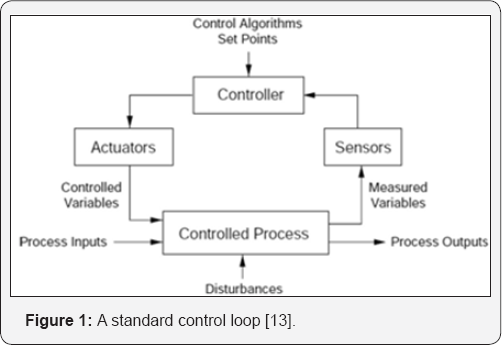
In this loop, Process Models have a significant role,
because automate (or human) controllers must be able to simulate the
under controlled process in their logic (or mind) for enforcement of
Control Action to keep the process operation within predefined limits.
Every controller, in fact, must contain a model of the processes that
are being controlled. Accidents happen when the controller's Process
Model does not match the system that is being controlled and,
consequently, the controller issues inappropriate commands [13]. Figure 2 shows a general control loop
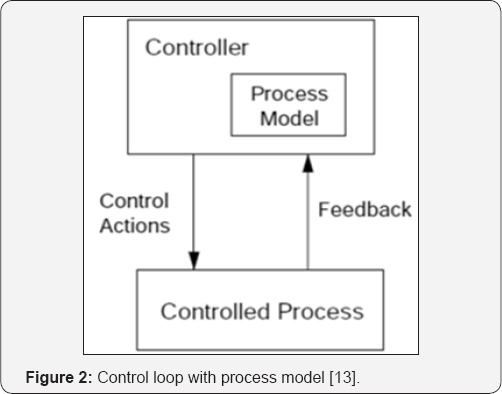
Organizational components need the same tools to do
their control duties; however, the type of the loop's components and
variables may be somewhat different. For example, organizational
variables and goals are not as clear as the technical variables.
Furthermore, feedback and actuator channels in organizational control
loops are forms and formal requests or reports; instead of signals or
other technical tools that usually are used in technical loops [21].
Moreover, Control Processes in organizational control
loops are not a mathematical function or logical algorithms. Actually,
organizational loops' control processes almost are a form of unclear
decision-making models that exist in decision makers' mind; the persons
who are engaging in decision making in the different level of the
organizational hierarchy. In fact, they may be either a technician, for
technical decision-making, or a top or middle manager for strategic or
executive decisions.
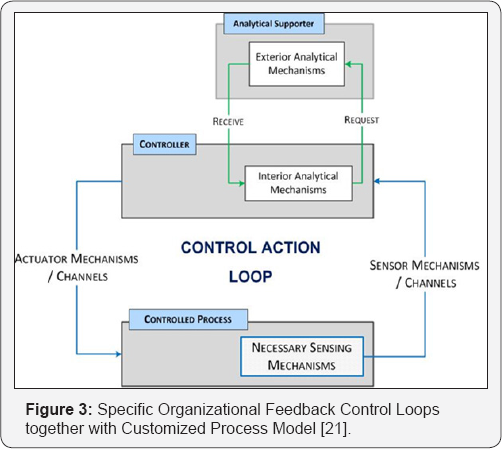
Organizational feedback control loop: In order
to apply STPA for initiating organizational hazard analysis, as the
main reason of this paper, it is needed to use a specific version of the
feedback control loop that was exclusively developed for deficiency
analysis of organizational safety control mechanisms. Figure 3 presents thisspecific Organizational Feedback Control Loop to gether with its customized Process Model [21]. Based on Figure 3, five requirements shall be met to accurately enforce the Control Actions by organizational control components:
a. A Necessary Sensing Mechanism must be active in
the process under control to collect, process, and prepare accurate
information for the control component. This mechanism is a type of
organizational processes that may be managed by either main control
component of the loop or other organizational components.
b. A reliable Sensor Mechanism (or channels) must be
active for delivering the prepared information to the control component.
This mechanism is also a type of organizational communication channel.
c. An Analytical Mechanism must be active for accurate processing of received information to determine appropriate
Control Action. This mechanism is also a type of
organizational processes. While Interior Analytical Mechanism is applied
by the control component of the loop, Exterior Analytical Mechanism is
applied via other organizational components (in a situation that
exterior analyzing is needed).
d. A reliable Request-Receive Mechanism must be
active to receive necessary information from other components (in a
situation that exterior analyzing is needed). This mechanism also is a
type of organizational process, which prepares appropriate context for
information exchange between Interior and Exterior Analytical
Mechanisms.
e. A reliable Actuator Mechanism (or channels) must
be active to enforce the Control Action to under control process. This
mechanism is also a type of organizational communication channel.
Modelling the system's organizational safety control loops: Based on Figure 4,
for modeling the system organizational safety control loops (As the
initial step of the Hazard Identification Process) a sequence of
procedures are needed that are described in the following.
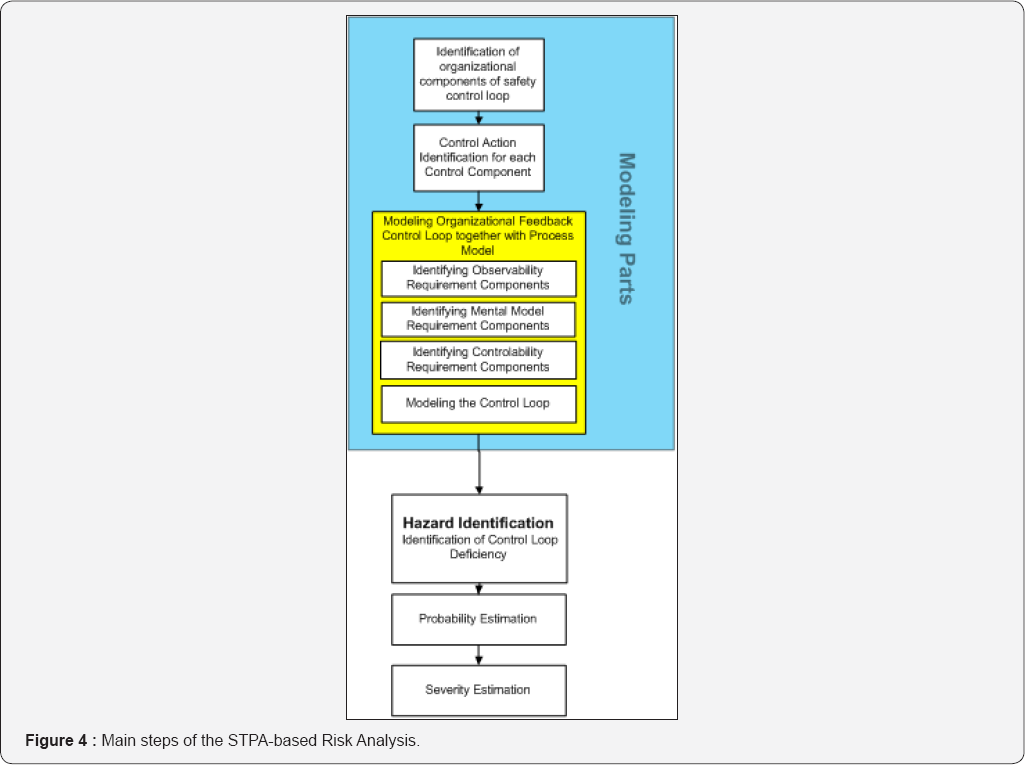
Identification of organizational components of safetycon- trol loop :
Before modeling the safety control loops for each control action of all
control components, as a main part of STPA, the control components must
be identified. Since our risk analysis model concentrates on
organizational roots of probable accidents, we focus on "organizational
control components" and their associated control actions.
Dulac recommended three important in formation
sources to identify Safety control Structure's organizational
components. Additionally, he recommended two criteria to summarize this
information for elicitation best set of these components [30]. These recommendations are reviewed as follow:
a. Org charts (Source one): He mentioned that, organization’s charts are a good start line for identification of organizational components.
b. Generic STAMP structures (Source two): The generic control structure that was shown in Figure 5,
can be used as an effective checklist to verify that important
components have not been mistakenly left out. He noted that, for many
systems, it is unneeded to follow the hierarchical structure all the way
up to the Congress and Executive components.
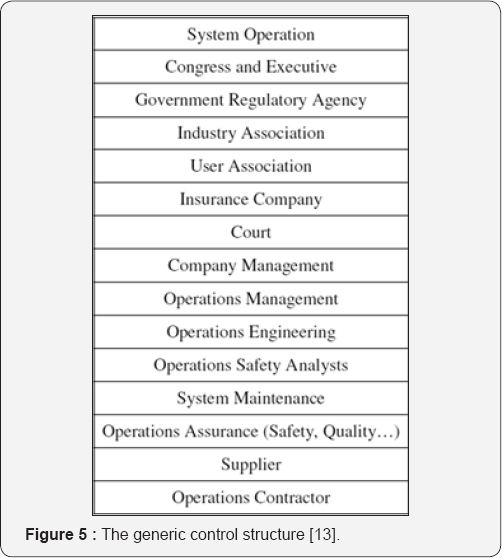
c. Interview data (Source 3): Another source
for identification safety control structure’s organizational components
is the interviewing from individuals within the structure itself. Dulac
stated that the emphasis should be on reviewing, improving and refining
the structure, eliciting informal structural connections that are not
represented in the official “party-line” organization chart.
d. Inclusion criteria (Criterion 1): He
prepared eight questions in order to decide whether an organization
component should be included in the model or not. However, Stringfellow
has added four more questions to the list for consideration of more
social features of the control structure [31]. Figure 6 lists the complete questions.

e. Combination criteria (Criterion 2): For
preventing of unnecessary complexity in control structure's model, it
can be possible and desirable to combine multiple components. As a
general rule, components that are structurally independent, but
functionally similar, should be combined unless they receive funding
from completely different or competing sources, or if they have
competing.
Control actions identification: Control
Actions are the actions that are enforced by control components to
control the system behaviors. Clearly, Control Actions are the reason
d’etre of the control components.It should be noted that, each
identified control components may apply different Control Actions to
control their under control processes; therefore, identifying all
components' Control Actions just is possible by scrutinizing all of
related documents and interviewing with organizational experts. Finally,
the results should be listed in an appropriate log [32].
Organizational feedback control loop modelling:
Now, in order to model organizational Feedback Control Loops - based on
the mentioned exclusive modelling diagram - all NonControl Actions
(Necessary Sensing Mechanisms and Analytical Mechanisms) must be
explored for each control component. Then, all requisite mechanisms, as
the Non-Control Actions, for accurate enforcement of each Control Action
must be specified. Finally, all Feedback Control Loops - together with
their Process Model - must be modeled according to the pattern that has
been presented in Figure 3.
Organizational hazard identification: “Working
around the loop” is the STPA’s principle to extract the hazards. In
fact, each of control loop's component should be regarded as a potential
source of systemic hazard; because any inefficient performance of them
can be able to cause a degree of incompetency in the control loop. This
local deficiency, consequently, eventuate to a level of inefficiency in
the whole system safety control structure; and, in a bigger picture,
leads to the system accost to a probable accident [33].
Accordingly, by using the Simplified General Causal
Factors, which are adapted from STPA original model and shown in Figure
7, different statuses of "Control Component Inefficiency" could be
extracted and regarded as the initiating mechanisms for systemic
accidents. These initiating mechanisms thus should be recorded as a
specific hazard for the probability and consequence estimation.
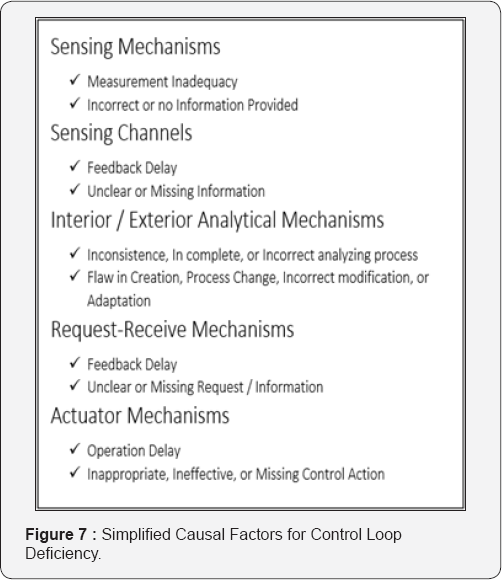
Risk estimation
Hazard activation likelihood (HAL): While
hazard is a dangerous dormant situation that triggers a mishap if will
be activated, the likelihood of the hazard is the probability of the
hazard activation. When we consider the hazard as the Deficiency in
organizational safety control mechanisms, we prepare this opportunity to
evaluate the Hazard Activation Likelihood (HAL) via the ratio of the
imperfect performances of the mechanism and the desired performance of
it at a specific period. Also, we can make a qualitative conception of
HAL by regarding experts' opinions and applying Table 1, if the reliable performance data is not available [34].
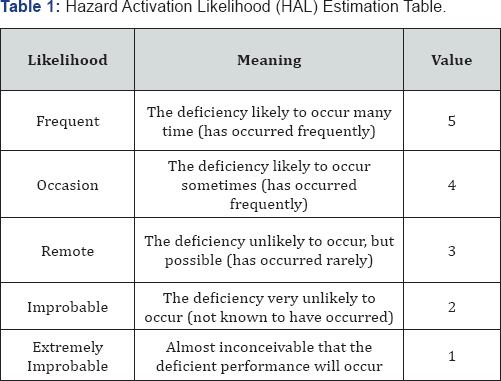
Hazard activation consequences severity (HACS) analysis:
In addition to Hazard Activation Likelihood
estimation, we need a clear rule to estimate the Hazard Activation
Consequences Severity (HACS), if we want to estimate the risk of any
hazards.
For making an appropriate way to estimate the
severity of the hazard activation consequences, we change the concept of
"consequence" from the real results of hazard activation (happening the
real mishap) to a new measurable quality that directly linked to
control theory. Actually, instead of seeking and modeling the
imperceptible results of defective mechanisms (as the hazards) on the
probable accident scenarios, we focus on the negative consequence of the
identified defective mechanisms on the whole Organizational Safety
Control Structure’s Competency (OSCSC).
This substitution can be meaningful because based on
STAMP pivotal thought, accidents in complex sociotechnical system happen
when the safety control structure cannot be able to control the
system’s behavior. As a result, it can be hypothesized that a defective
mechanisms are able to cause a kind of deterioration on the safety
control structure, and then, the dormant systemic hazards become active
and initiate a complex and imperceptible chain of events that finally
eventuate to a mishap; or at least, can push the system toward a more
hazardous situation [35].
When it is impossible to estimate the role of a
specific defective mechanism on the formation of accident scenarios, it
can be feasible to be focused on "consequent deterioration” in safety
control structure; the deterioration that can be regarded as a preceding
status of a probable catastrophic accident.
The whole OSCSC is an abstract concept that shows
"how well safety control structure enforces desirable system safety
constraints”. This concept stands on the system theory, the control
theory, and specifically, main concept of STAMP and STPA model.
According to these theories and models, the main mission of "Safety
Control Structure" is to enforce specific constraints to ensure that the
system will be keeping in a safe zone when has to tolerate unavoidable
and continuous changes. In fact, system's control structure must have an
appropriate dynamicity to constrain the real dynamic system in each new
position.Nevertheless, in a specific point of time, the real control
structure may not completely conform to the desired control structure.
This unconformity and gap may have some causes such as control structure
design inappropriacy, imperfective performances of some control
structure's components, or unfit adaptation of the control structure [36].
Accordingly, the whole OSCSC is a concept that can be
able to reflect the experts’ overall opinion about the real control
structure proficiency. The experts, in fact, are able to qualitatively
estimate the effect of a specific deficient mechanism, which was
explored in the hazard identification phase, on the Safety Control
Structure's Competency. The severity of this effect, consequently, is
able to take the place of the "Hazard Severity" in the risk analysis
procedure [37].
Risk evaluation
Risk evaluation is the process of comparing estimated risks with established risk evaluation
Case Study (Figure 8-10)


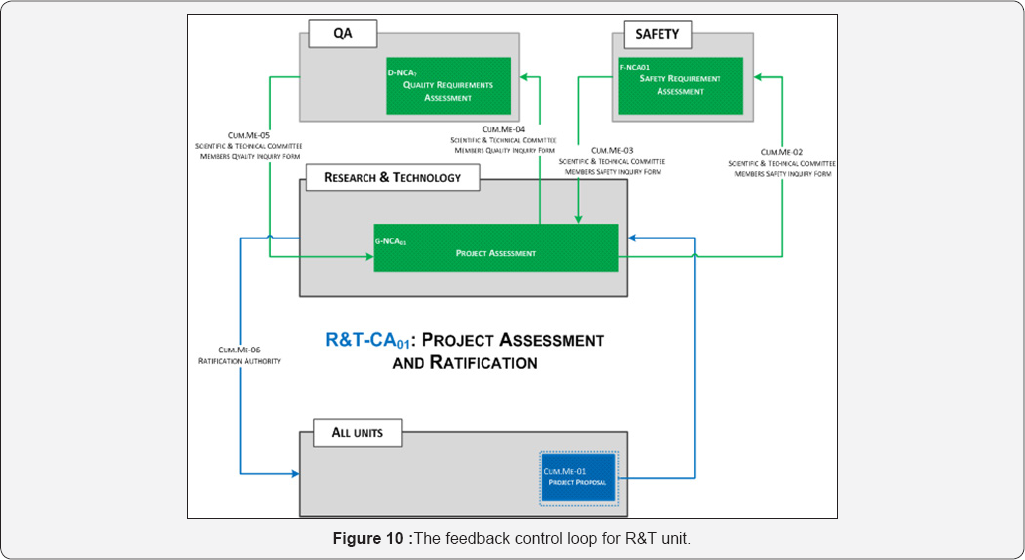
Summary and Results (Figure 11)
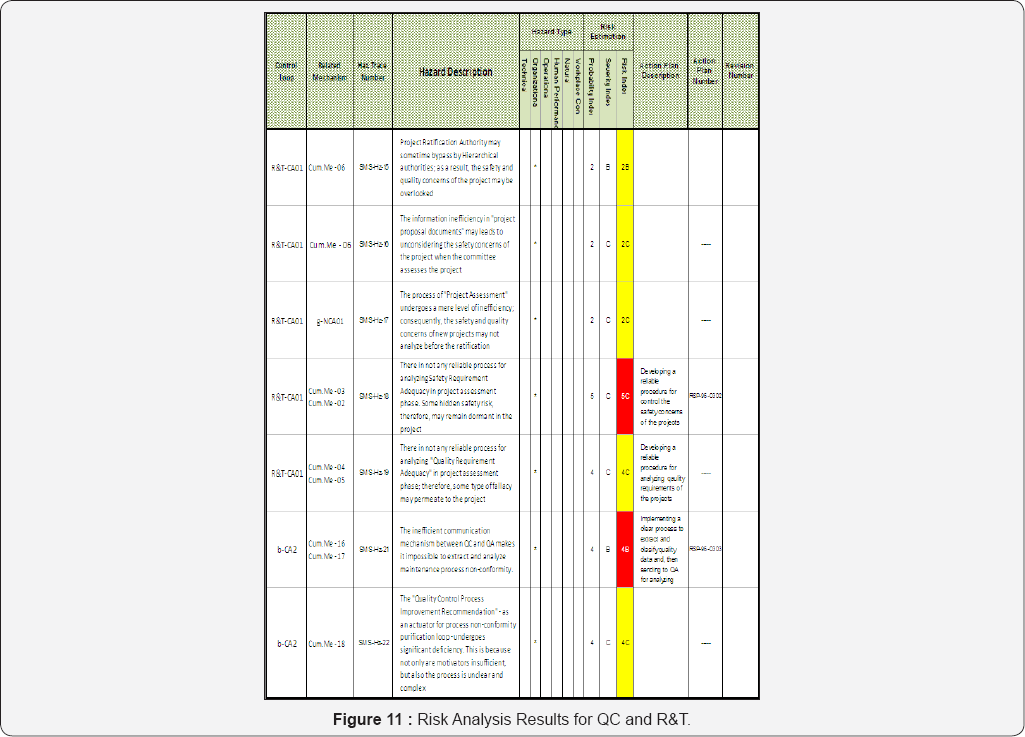
Conclusion and Discussion
For precise evaluation of OSCSC, certainly, we need
more data to model the relation network between safety structure's
components;nevertheless, in the initiating phase of organizational risk
analysis we can rely on experts judgment.
Table 2
is presented to estimates the severity of a consequence that is
initiated from specific organizational hazard by extracting experts'
opinions.
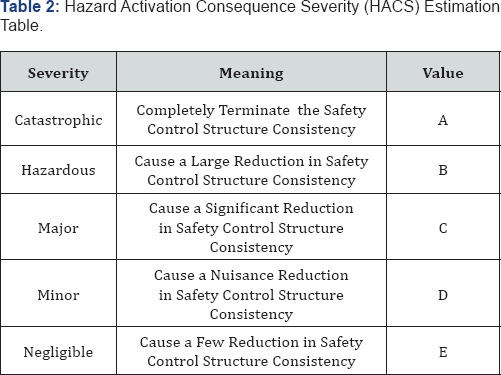
Finally, the estimated risk is described in a
qualitative term by a combination of two characters that the first
demonstrates the Hazard Activation Likelihood (HAL) and the second
demonstrates the Hazard Activation Consequence Severity (HACS); such as
3A, 5B and the like.
Criteria (e.g. criteria based on the best available
technology, legal requirements, practices, processes, or achievements)
in order to determine the level or significance of risks and provide
recommendations for the decision-makers at various levels [6].
Although "Risk Evaluation" is beyond this paper’s scope, As Low As
Reasonably Practicable' (ALARP) strategy usually employs for managing
the risks. In the case study section, a simple table is applied as a
sample for the risk evaluation criteria.
In the following, the presented STPA-based
organizational risk analysis framework is applied - in limited scale -
to extract organizational safety-related hazards and estimate their
risk. The case is a sample aviation industry that is responsible for
maintenance and modification of Iran’s helicopter fleet.
Accordingly, only two organizational safety control
components together with their related communication mechanisms, and
their inter-connected non-control components (analyzing or supporting
components) were selected for further analysis. These two organizational
components include Quality Control (QC) unit, and Research &
Technology (R&T) unit. The first one is responsible for managing the
main and the most comprehensive control mechanisms in case industry.
The second one controls modification projects via its ratification
authority.
Based on the modeling pattern, which is illustrated in Figure 3, all control requisite mechanisms have been identified and, then, the control loops have been made (Figure 8 For QC and Figure 9 for R&T).
After modeling the control loops, all parts of the loops have been analyzed by means of the Simplified Causal Factors (Figure 7)
in order to extract any probable deficiency; then, a group of experts
estimated the probability of each extracted deficiencies via applying Table 1. This group of expert, then, applied Table 2.
to estimate the probable consequence of the identified hazards on the
whole OSCSC; after all, the risks of the hazards are evaluated by means
of Figure 10; as a simple method for prioritizing the necessary control actions. Finally, the results have been summarized and depicted in Figure 11.
For initiating the process of organizational-based
safety risk analysis in aviation industries, which is needed concerning
ICAO's safety management system (SMS), an innovative and specific
framework have been presented in this paper. This framework was built on
the Control Theory and, specifically, the STPA model. Based on this
model’s main concept, catastrophic accidents in complex socio-technical
systems originate from the Safety Control Structure deficiency.
Accordingly, the new framework is concentrated on Organizational Safety
Control Loops deficiency (as the hidden hazards) and the effect of these
deficiencies on the whole Organizational Safety Control Structure
Competency (as the consequence of the hazards).
For presenting the main procedures of the framework,
its modeling and analyzing parts were described separately. The modeling
part is made of a series of steps to identify organizational control
components, control actions, and model the control loops. The analyzing
part is responsible for extracting defective mechanisms that are placed
in control loops by use of a series of guide-words, which is named
Simplified Causal Factors. This part also is responsible for evaluating
the Hazard Activation Likelihood and the severity of Hazard Activation
consequences.
For estimating likelihood of the hazards and severity
of the consequences, two specific tables were presented as the guide
tools for experts' judgment. Finally, the framework was limitedly
applied in a case aviation organization to clear its sequence and
procedures, as well as its applicability.
The presented framework is developed for analyzing
the organizational-based safety hazards that are hidden in the
operational phase of the system. We, consequently, assumed that all
high-level hazards of the system had been identified and adequate
control components with clear responsibilities had been embedded in the
system to control them; however, it is possible that some of the control
mechanisms had been eroded or outdated in the result of system dynamic
behavior.
According to this assumption, we neglected some of
initiating steps of STPA that are related to "System-Level Hazard
Identification" and "Safety Constraints Identification". In fact, we
started the hazard identification process from extracting current
organizational control components and their responsibilities.
Nevertheless, we admit that a comprehensive analysis, which should be
done in the next rounds of a continuous risk management cycle, must
start at "System-Level Hazard Identification" and continue separately
for each system-level hazard.
Furthermore, a more advanced analysis should be
developed based on more quantitative and precise data for "Hazard
Activation Likelihood" and "Hazard Activation Consequences Severity"
estimation. Increasing preciseness of these two quantities can be able
to help system engineers and decisionmakers to find and concentrate
critical mechanisms of the control structure for launching more
appropriate improvement plans.
In addition, the evaluated risk (the combination of
HAL and HACS) of each safety-related organizational mechanism has a
meaningful dynamic feature. This is because both the imperfect ratio of
organizational mechanisms and the whole Organizational Safety Control
Structure Competency are sensitive to organizational dynamicity. As an
important result, the estimated risk could help system engineers to
design remarkable leading indicators as the predecessor of system
hazardous behaviors.
For More Open Access Journals Please Click on: Juniper Publishers
Fore More Articles Please Visit: Civil Engineering Research Journal


Comments
Post a Comment